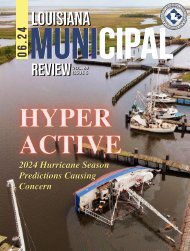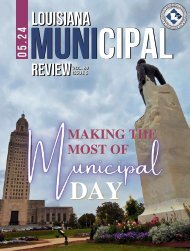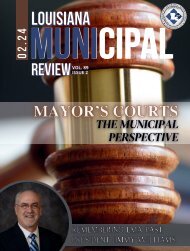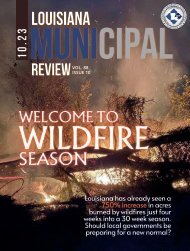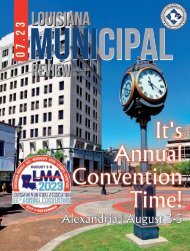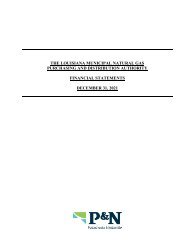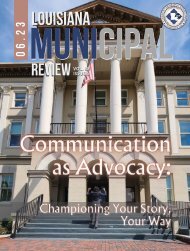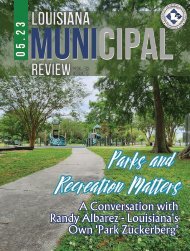GOHSEP Elected_Officials_Manual_2015
You also want an ePaper? Increase the reach of your titles
YUMPU automatically turns print PDFs into web optimized ePapers that Google loves.
Threats + Hazards<br />
Identification + Risk<br />
Assessment (THIRA)<br />
To begin pre-disaster preparations, conduct a THIRA.<br />
A THIRA:<br />
• Defines threats and/or risks through a hazard<br />
assessment process.<br />
• Articulates expected outcomes as stated in<br />
the Emergency Operations Plan (EOP), Debris<br />
Management Plan, Recovery Plan and any<br />
other related plans that might be in place.<br />
• Identifies internal resources that support<br />
expected outcomes.<br />
• Includes a gap analysis.<br />
• Determines what external assets are needed<br />
to support expected outcomes.<br />
A hazard assessment<br />
process determines . . .<br />
• What types of hazards may occur and<br />
how they will affect an area.<br />
• Which populations or areas are likely to<br />
be affected by each type of hazard.<br />
• How much damage is expected to occur<br />
in those areas should a hazard-related<br />
emergency or disaster occur.<br />
• The likelihood and frequency of each<br />
hazard.<br />
Mutual Aid Agreements<br />
(MAA)<br />
MAAs take many forms. They are also referred to as<br />
Memorandums of Understandings (MOUs). A MAA is<br />
an agreement between jurisdictions or agencies<br />
to provide reciprocal services in the event of an<br />
emergency or disaster.<br />
Parishes are encouraged to enter into agreements as<br />
allowed pursuant to Louisiana Revised Statute (LRS) Title<br />
29:739 Intrastate Mutual Aid Compact (IMAC). LRS 29:739<br />
allows for intrastate mutual aid between Parishes within<br />
the State, to provide and promote mutual assistance in<br />
the prevention of, response to and recovery from an<br />
emergency or disaster. This statute mirrors the interstate<br />
Emergency Management Assistance Compact (EMAC)<br />
(approved by the United States Congress (USC) by Public<br />
Law [P.L.] No. 104-321, 110 Stat. 3877).<br />
Mission Ready Packages (MRPs)<br />
Mission Ready Packages (MRPs) describe specific<br />
response and recovery resource capabilities,<br />
including credentialed personnel, that are organized,<br />
developed, trained and exercised prior to an<br />
emergency or disaster. MRPs are important to mutual<br />
aid because they allow for rapid identification,<br />
locating, requesting, ordering and tracking of<br />
specific resources quickly and effectively during an<br />
emergency, when time is of the essence. Because<br />
MRP development involves establishing a quality cost<br />
estimate before an emergency occurs, they also result<br />
in a well-documented reimbursement package and<br />
more efficient reimbursement.<br />
MRPs are based on National Incident Management<br />
System (NIMS) resource typing but take the concept<br />
a step further by considering the mission, limitations<br />
that might impact the mission, required support,<br />
2.1 Pre-Disaster Preparation Page 2 of 4



